We Test the Hottest Six Family Sedans of 2012-2013
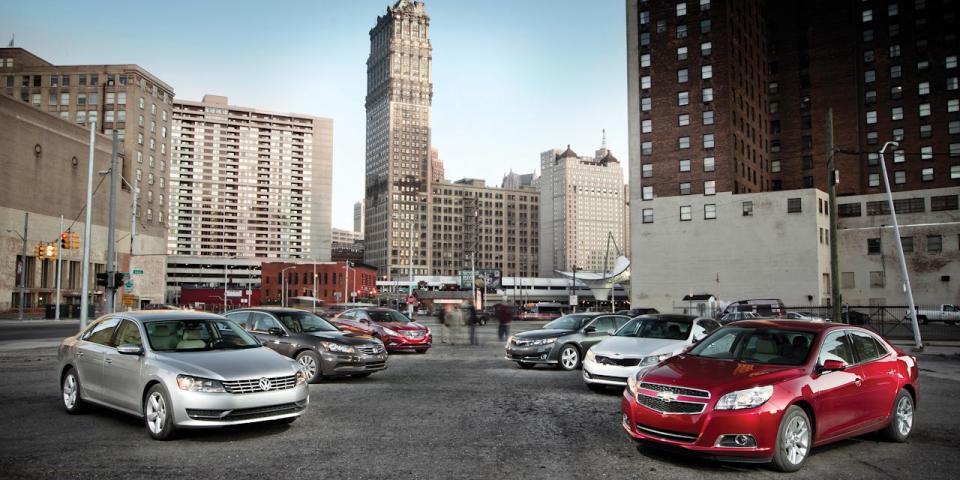


While driving toward our southern-Ohio handling loop, we stopped at a familiar haunt: the Toy Barn, in Dublin, Ohio. Justin Hinderer’s barn, erected in 1972, still houses horses and bulls, but nowadays they’re prancing and raging Ferraris and Lamborghinis, with the odd Ford GT and Audi R8 thrown in for philosophical contemplation. If we wanted to photograph our mainstream sedans inside Hinderer’s barn, well, we’d first have to help him empty the place of roughly $900,000 in pre-owned exotica. On a frigid February day, it really clears the sinuses to light off a chrome-yellow Mallett Corvette.
The 4000-square-foot Toy Barn is even adorned with original CHEW MAIL POUCH TOBACCO signage, personally autographed by Harley Warrick, the late Ohioan who spent 55 years decorating more than 20,000 such barns. “The first 1000 were a little rough,” he said. “After that, you get the hang of it.” Warrick could sometimes knock out six barns a day.
We sure can’t knock out six family-sedan tests a day. Not even close. For one thing, the cars have become spectacularly good and a lot alike. In this mainstream category, the sales and profits boil in a perpetually red-hot stew of cutthroat competition. Engineers will tell you that creating a 500-hp $100,000 supercar is child’s play compared with creating a family sedan. For one thing, the average base price must nowadays hover around $25,000. The car must graduate from the EPA with something close to a 24/35-mpg diploma. It must offer a borderline-luxurious cockpit, an absorbent ride, some measure of handling, a trunk with about 15 cubic feet of storage, and a back seat that absolutely will accommodate three adults. At C/D, we ask for two further perks: some semblance of driving gratification and a sense of character.
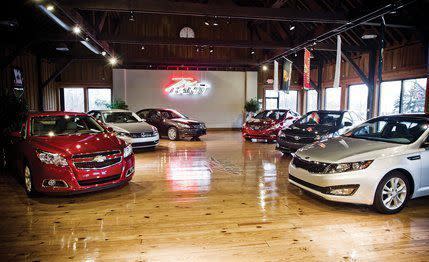
In this competition, we’ve included the Chevrolet Malibu and the Toyota Camry because they’re brand-new. We felt compelled to include a five-cylinder Volkswagen because the Passat has already won a comparo in V-6 guise [October 2011]. The Hyundai Sonata was included for its victory in our “Practically Chic” shootout [May 2010]. Since 2007, we’ve failed to include its sister ship, the Kia Optima, in any ménage à six-pack, so why not now? And the Honda Accord tagged along like the little brother that it is, this time by dint of its 10Best laurels. Notice, however, that the Accord is long in the tooth, with the ninth generation slated to roll out this fall.
Let us now speak of the cars that were excluded. A Chrysler 200 was rejected as not yet rising to status sufficient to distinguish itself in this fierce category. The Mazda 6 is so at the end of its rope that, out of fairness, it was banished. A Subaru Legacy eliminated itself by finishing third against the Accord and Sonata in our “Practically Chic” trio. And a Suzuki Kizashi is a few cubits too wee for mid-size consideration.
We definitely would have included a Ford Fusion but prefer to wait for the spectacularly restyled version arriving at the end of the year. Likewise arriving shortly is a new Nissan Altima. Rest assured that all of these combatants will cycle through similar upcoming competitions in what has become our own recurring Groundhog Day.
As we visited the Toy Barn, a civilian approached and said of our Malibu, “I’m glad you’ve got at least one American car in the mix.” Fun fact: Every car in this comparo is built in America.
Even funner fact: While Harley Warrick was painting a barn in Indiana, high winds tore the roof clean off. His assistant inquired whether they should flee. “Hell, no,” said Warrick. “This side is still standing.”
Here are the six hottest family sedans still standing.
This summer, the more traditional gas-only Malibus will arrive, but for now we have only the Eco model. It features a motor/generator that replaces the alternator, adding 15 horses to the crankshaft, mostly at wide-open throttle. Thirty-two lithium-ion cells reside in a 65-pound battery pack in the trunk, doing damage to cargo capacity. In fact, this is now the smallest trunk in our group.
During our tests, no editor felt the motor kicking on or off, but we all certainly felt a mushy vagueness in the brake pedal—a non-linearity common to regenerative braking and a trait that didn’t manifest during our first Eco drive [December 2011]. This Malibu is also fitted with automatic stop-start. In our hands, however, the engine rarely winked off. As in, almost never.
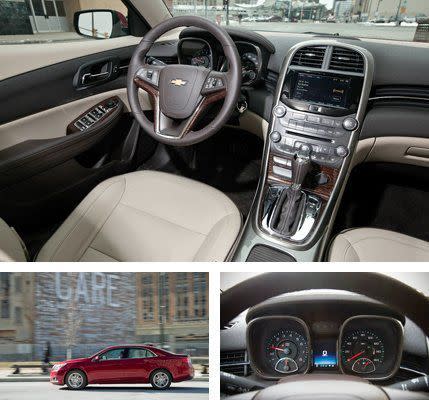
The whole point, of course, is fuel economy, and that’s the only reason you’d put up with the Eco’s added complexity, expense, and weight. Indeed, the Malibu was the heaviest of our contestants, 346 pounds chunkier than the Camry. So when the Eco returned an observed 26 mpg—same as the Accord, Camry, and Passat—well, it made
us feel as though we were attending AA meetings to cure an addiction to Betty Crocker rum cakes.
The Malibu lost further points for its claustrophobic cockpit—“like sitting in a pillbox,” said road-test editor Mike Sutton. Although this is the widest car in the group, its rear seat is barely habitable with three adults aboard. And the car is never much fun. It offers almost no steering feel. Its transmission can be shifted manually only if your right arm readily folds into an S-shape. And upon turn-in, the suspension disconcertingly transitions from full flaccid to gratuitously granitic.
To its credit, the Malibu proved singularly adept as an interstate cruiser. It was far quieter at 70 mph than its competitors—no wind or impact noise—and the nine-speaker, 250-watt Pioneer stereo could be plumbed to stunning effect. But for now, thanks very much, we’ll await the upcoming LS, LT, and LTZ.
Toyota asserts that its seventh-gen Camry has helped lower the average age of buyers from 60 to 52. So soon after the new car’s introduction, how could the marketing guys know? Well, when you sell 28,295 units in January alone—displacing the Chevy Silverado as the second-bestselling vehicle in America—you have quite a sizable demographic pot from which to sample.
This latest Camry adheres limpet-like to the traits of its predecessors. The styling—inside and out—will offend no one, unless you’re offended by interior surfaces that would be appropriate in a budget motel. It’s one thing to fashion fake brushed aluminum out of plastic, but should the surface also feel as if you could scar it with your fingernails?
In city traffic and during crowded commutes, however, the Camry remains an almost narcotically serene place from which to conduct business. The engine produces a distant thrum, “as if it were corked,” said contributor Phil Berg. It was easily the quietest at full throttle. At speed, road noise is muted, yielding near tomb-like silence.
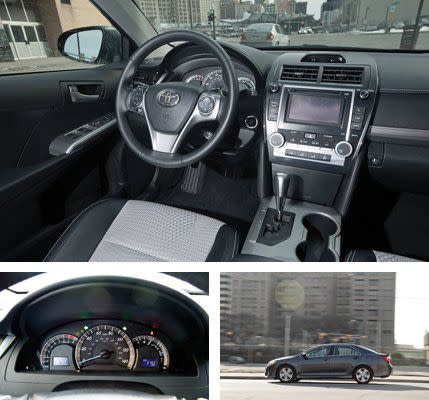
On more entertaining byways, the Camry resists the whip. Brake feel is missing, the electric power steering doesn’t offer much on-center feel, and there’s no lateral seat support. Body motions aren’t exactly sloppy, but they’re undisciplined. Facing this Toyota’s suspension, however, Michigan’s potholes and frost heaves were roundly defeated.
What’s more, the Camry’s back seat proved the most satisfying for three adults. When there were only two men inhabiting that bench, one editor commented, “I could ride—and sleep—back here all day.”
If, after a hectic day, your notion of bliss is driving home in your living room, here’s your automobile. The Camry remains a starter kit for a Lexus, served up at the lowest base price in this group. Historically, that’s been a recipe for profits.
The Optima and Sonata offer the most standard horsepower in this class. Which attracts us as a Flashback Pheasant Tail attracts brook trout. Riding on the only 18-inch rubber in our group, the Sonata was quickest to 60 mph, earned the lowest quarter-mile ET, topped both our top-gear tests, and was the fleetest from 5 mph to 60 mph. When it came to whoa, well, the Sonata aced that, too, knocking out the shortest braking distance from 70 mph. Then it went on to serve up the second-fastest pass through our 610-foot slalom. Quite a résumé.
Since this car’s debut as a 2011 model, it seems there’s been a sample in our Ann Arbor fleet every other week, so we’ve chronicled its traits in detail. To recap: The steering can’t match the Volkswagen’s accuracy, but at least it’s “two-finger spinnable” at parking-lot speeds. The chassis is competent with good damping and roll control. Throttle tip-in is gentle, as velvety as the Camry’s. Speaking of the Toyota, this Hyundai is only one decibel noisier at full throttle. All primary controls are fluid and willing, ditto the secondaries (apart from a radio-volume-control knob that is perversely designed to resist human fingers). The cockpit’s solid design is marred only by its remorseless blackness.
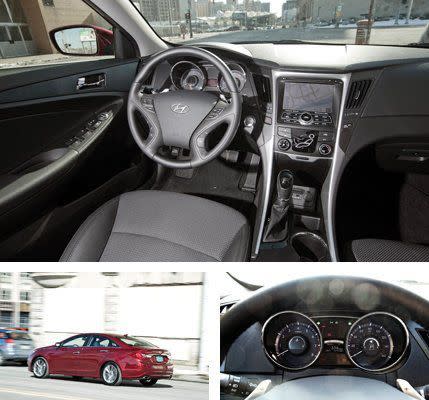
As in the Optima, the Sonata’s shifter is mounted too far astern to feel natural in its movements, but the paddles on the steering wheel save the day. Still, we wish the shift-response times were quicker. And, in traditional “D” mode, the Hyundai-engineered transmission remains too eager to grab the highest gear possible.
In our “Practically Chic” comparo, a Sonata SE defeated an Accord EX, although by six points only. The tables were gently turned this time out, mostly because we found we prefer our Sonata swathed in Optima clothing. But the Optima engaged in further cannibalism. Its front seats, its interior styling, its ergonomics, its ride, its plethora of amenities—all surpassed the Hyundai’s. And the huge rear seat in the new Camry, to cite another newcomer’s strengths, made the Sonata’s feel comparatively cramped.
New blood has a long history of exposing foibles.
The Koreans in this test share a platform and a drivetrain. Shouldn’t they feel identical on the road?
Nope.
The Optima’s front track is wider than the Sonata’s. No sheetmetal is shared. The front seats differ. Dashboards are wildly dissimilar. The Optima’s steering is slower. The Kia’s center of gravity is an inch higher than the Hyundai’s, in part due to that huge pane of glass behind the Optima’s traditional sunroof. And each company goes its own way in suspension tuning and tires. Which may explain why the Sonata’s braking from 70 mph was the shortest (tied with the Passat) and the Optima’s the longest. Tires by Nexen? Who?
What the Optima did best was wow us with its luxurious and tasteful cockpit and with switchgear that was thoughtfully labeled and logically laid out—with the exception of the hidden button for the steering-wheel heater. Plus, the Optima’s driver’s seat could serve as the model for this whole segment: supportive in the back country, all-day comfy on the interstates. In addition,we adored the fat, classy, leather steering wheel. Too bad the shifter is too close to the driver’s elbow.
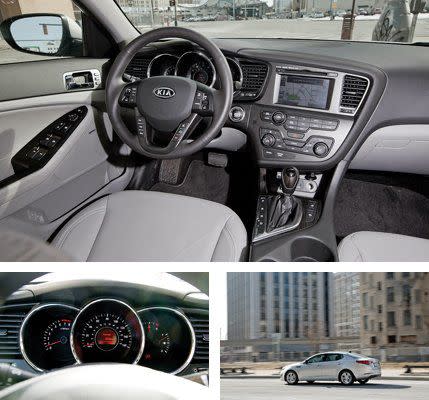
Funny how the Koreans have both ends of the styling spectrum covered. While the Sonata brandishes a zoomy, crisply creased look, the Optima evinces the understated, almost feminine figure of a Jag or an Aston.
Combine that with 200 horsepower delivered in a wide band, ride quality that equals the VW’s, the quietest idle, along with the most gadgets, and, well, you realize how far Kia has come since we tested that “high yawn factor” Optima in 2007.
Kia sold 84,590 Optimas last year and couldn’t keep up with demand. That’s why the West Point, Georgia, plant will this year boost production by 60,000 units. Optima optimistic? More like realistic, we’d say.
A 10Best victor 26 times, the Accord has pretty much exhausted all of the glowing adjectives that D. Webster ever cataloged. The descriptor that characterizes the car right now, however, is “aging.”
Until we tackled our handling loop, in fact, the Accord felt like a midpack finisher. Its transmission offers only five speeds. It tied with the Camry for dullest cockpit styling. Its 190-hp engine churns out the least torque. There’s no exterior latch to open the trunk. And it proved the noisiest at full throttle—a barrage of intake roar and singing belts and thrumming valves.
On our handling loop, however, the Accord quickly became an ally, processing all dynamic inputs with confidence and immediacy. It felt uncrashable. The steering reveals road textures; it talks to you about remaining lateral grip; it gladly pursues one steady path with no midstream corrections. The brakes allow those gratifyingly smooth panic stops that you can magically hold on the edge of anti-lock. The chassis is so rarely surprised that it makes its driver feel invincible.
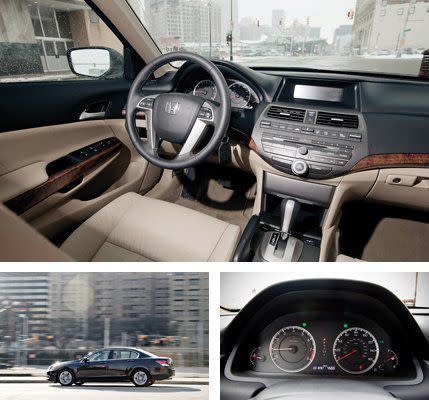
Sample logbook entries: “Close, short-travel pedals with no wasted movement.” “Crisp, purposeful steering that requires little attention.” “A platform so sound that not even Sherman in one of his forefathers’ tanks could bend it.” “Never hunting for gears midcorner.”
The ninth-gen Accord arrives this fall, so the “old” car’s performance here is all that more stunning. Notice, however, that the Accord finished one meager point ahead of the Optima, which was only two points in front of the Sonata. Pretty much a statistical tie. Had even one editor been harsher in judging, say, the Accord’s lackluster interior, the car’s second-place ranking might well have been snagged by the Optima.
Notice that in steering feel, brake feel, and handling, the Accord marginally bested the Sonata this time out. For one thing, this Accord was 0.5 second quicker than the “Practically Chic” California car, but it also demonstrated better braking distances and slightly better skidpad grip. See how evenly matched these family sedans have become.
To admit he’s wrong, a man must have integrity and modesty. Plus maybe a shot of Jack Daniel’s, distilled not too far from the Passat’s birthplace. We initially took potshots at this “sized-for-America” Volkswagen because it has been somewhat condescendingly reconstituted for obese North Americans whose notion of haute couture is the Diamond Gusset collection.
Well, we’re getting over it. What you notice first about the Passat is that it’s easier to climb into than its competitors, and the cabin has the bright, open, airy feel of a small gymnasium. Sightlines are superb, largely due to that immense, flat slab of a windscreen. Which, of course, contributes to the Passat’s exterior fashion statement. But we’re getting over that, too. One thing the boxy styling engenders is cargo space—as in a trunk as useful as the Sonata’s and the most rear interior volume.
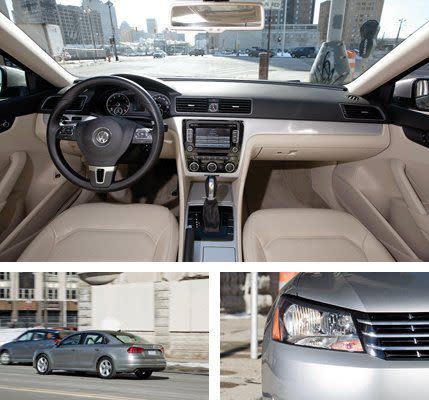
Like the Accord, the Volkswagen was registering fair-to-middling impressions for the first two-thirds of our test. That its engine was eking out the least power from the most cylinders certainly didn’t help, although the car is lively out of the blocks, logging the quickest sprint to 30 mph. In fact, it wasn’t until we hit our handling loop that we fully probed the Passat’s winning slalom athleticism. On serpentine byways, sure enough, it summoned the best steering and brake feel, a transmission that could often predict the driver’s next move, and a ride/handling trade-off that wasn’t so much a trade-off as a victory on both counts. “Somebody sweated the suspension calibration,” noted tech director Don Sherman. Moreover, the German engine matched the Camry’s for lowest levels of NVH, and the cockpit ergonomics equaled the Optima’s.
There remain flaws. Why can’t we turn off the stability control? Why is there so much wind roar at speed? How come the steering wheel is a little cockeyed? Why don’t we fit into our Gussets?
Bottom line: The Passat evinced the best fit and finish. It was the most fun to drive. You can own one—with a five-speed manual—for as little as $20,765. Know what? That is the American way.
('You Might Also Like',)

 Yahoo Autos
Yahoo Autos 